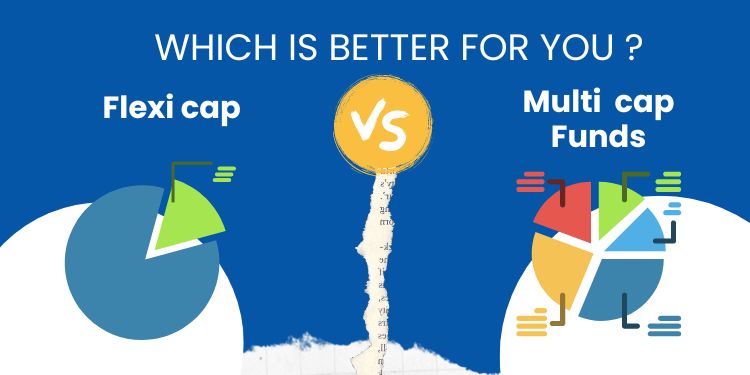When it comes to building wealth, one of the most attractive options available to investors is investing in equity mutual fund schemes. While these funds carry higher risks, they can be excellent for long-term growth as a longer perspective can help you ride out short-term market fluctuations and allow your money to compound over time. According to the Securities and Exchange Board of India (SEBI) guidelines, a mutual fund is called an equity fund if it invests at least 65% of its total corpus in equities.
However, within the equity category, there are several types of mutual funds, such as large-cap, mid-cap, small-cap, ELSS, multi-cap and flexi-cap funds. Understanding the differences between these can help you make better investment decisions. Before we go any deeper into multi-cap and flexi-cap funds, let’s first clarify the definitions of large-, mid-, and small-cap stocks based on their market capitalisation:
- Large-cap companies are those which are ranked between 1 and 100.
- Mid-cap companies are companies ranked between 101 and 250.
- And finally, companies ranked 251 and beyond are classified as small-cap companies.
Different equity funds follow specific rules set by SEBI. For example, large-cap funds must invest at least 80% of their portfolio in large-cap companies. Similarly, other funds like multi-cap and flexi-cap have their own requirements. With this basic information, we are ready to jump into the flexi cap vs multi cap battle. Let’s begin!
What are Multi-Cap Funds?
As the name implies, multi cap funds invest across all three market capitalisations – large, mid, and small. According to SEBI rules, multi-cap fund managers are required to allocate a minimum of 25% of their portfolio to each of these three market caps. Because of this spread, multi-cap funds are also known as diversified equity funds. Thus at least 75% of investment is made in equity and equity-related instruments in these funds.
With this balanced approach, investors can gain exposure to different areas of the market. Multi-cap funds are considered less risky compared to small-cap and mid-cap funds, where managers are required to invest at least 65% of their assets specifically in small-cap and mid-cap stocks respectively.
What are Flexi-Cap Funds?
As with any other equity mutual fund, all flexi cap funds need to invest at least 65% of their portfolio in equity and equity-related securities. Unlike multi-cap funds, flexi-cap funds are not bound by the limits set by SEBI. Here, the fund manager is allowed the flexibility to dynamically allocate assets between large, mid, and small-cap companies. This allocation depends on the market conditions, valuations, and opportunities.
For example, if the manager is looking for stability, they can allocate the majority of the fund’s assets to large-cap stocks. Similarly, during bullish phases when mid and small-cap stocks are performing well, the manager can increase exposure to these smaller areas to capitalise on their higher growth potential.
Key Differences Between Multi-Cap Funds and Flexi-Cap Funds
Even though both multi-cap and flexi-cap funds are equity mutual funds, there are a few notable differences between the two. Check out the differences between multi cap vs flexi cap funds below:
| Factor | Multi-cap Funds | Flexi-cap Funds |
| Meaning | Multi-cap funds are a type of equity mutual fund where the fund manager must invest a minimum of 25% of the portfolio in small, mid, and large-cap stocks each as per the SEBI guidelines. | Flexi-cap funds are also a type of equity mutual fund, however, they do not have any allocation restrictions like multi-cap funds. Fund managers can invest any percentage of the portfolio in large-cap, mid-cap, or small-cap stocks. |
| Flexibility | Due to the minimum allocation to all three market caps, multi-cap funds aren’t very flexible. | The fund manager has complete freedom to determine the fund’s equity allocation across the market caps, making it flexible. |
| Minimum Equity Exposure | A minimum of 75% of equity exposure must be maintained (25% for large-, 25% for mid-, and 25% for small-cap stocks) | At least 65% of the fund’s assets must be allocated to equities. |
| Fund Manager Discretion | Fund managers have less freedom due to SEBI’s restrictions. | Fund managers are free to decide allocation based on market conditions. |
| Risk | These plans are riskier compared to flexi-cap funds, as the 25% allocation to each market cap must be maintained at all times. In case of market downturns, multi-cap funds have less flexibility to adjust their allocation, so they are still required to maintain significant exposure to riskier mid and small-cap stocks. | Risk varies depending on the fund’s allocation. For example, a flexi-cap fund with a high investment in large-cap companies is less risky compared to a multi-cap fund or another flexi-cap fund with a majority investment in mid and small-cap companies. Generally, however, flexi-cap funds are considered safer than multi-cap funds because, during downturns, the fund manager can turn to the more stable large-cap stocks. |
The main difference between flexi cap vs multi cap funds is the SEBI mandate. Multi-cap funds have to allocate at least 25% of their corpus to each of large, mid, and small-cap stocks, whereas there is no mandatory allocation requirement for flexi-cap funds. This clear distinction has a direct impact on the risk and return profiles of the two types of funds.
Performance Comparison: Multi-Cap vs Flexi-Cap Funds
Now let’s compare the performance of flexi cap vs multi cap funds. Their returns depend on several factors such as market conditions and the fund manager’s expertise. However, here’s how they generally tend to perform. Due to the SEBI mandate, multi-cap funds allocate a minimum of 50% to small and mid-cap companies at all times.
These companies have higher growth potential compared to stable large-cap stocks, which means multi-cap funds can offer very strong returns during bullish market phases when mid and small-caps are performing well. At the same time, this minimum allocation can add extra risk during market downturns when small and mid-cap stocks tend to fluctuate a lot.
On the other hand, flexi-cap returns are generally lower compared to multi-cap funds because the lack of restrictions allows fund managers to allocate more to large-cap stocks. These funds generally invest more in large-cap stocks for more stability. When the market gets bullish, the fund manager can allocate more of their resources to small and mid-cap stocks to take advantage of the soaring prices. However, during downturns, the manager can also allocate the majority of the corpus to large-cap stocks to fight volatility and reduce risk.
Who Should Invest in Multi-Cap Funds?
Multi-cap funds are also known as diversified equity funds because they focus on all three market caps. So investors looking to gain exposure and diversification across large, mid, and small-cap stocks can consider multi cap funds. These funds can be risky in the short term, so investors should also have a long-term vision when investing. For example, these funds can be an ideal vehicle for long-term goals such as building an education fund for your children or a retirement fund.
Who Should Invest in Flexi-Cap Funds?
Flexi-cap funds also offer market cap diversification, but not to the extent of multi-cap funds. This is because even without any allocation restrictions, flexi cap funds generally allocate a higher percentage to large-cap stocks for higher stability. Their returns are slightly lower compared to multi-cap funds, but they are also similarly less risky due to the dynamic asset allocation.
So investors who are fine with relatively lower returns in exchange for comparatively less risk can consider flexi-cap funds over multi-cap funds. However, just like any other equity fund, a systematic and long-term approach should be taken when investing in flexi-cap funds.
Ready to grow your wealth?
Partner with Fincart for expert investment planning and make your money work for you.
Risks Associated with Multi-Cap and Flexi-Cap Funds
Both, multi-cap as well as flexi-cap funds are subject to market risk. Since both schemes invest heavily in equities, the risk associated with them is considerably higher than debt and hybrid mutual funds. Over the long term, however, this risk tends to go down as your investment gets more time to get over the short-term fluctuations.
If we compare the risk level between multi cap vs flexi cap funds, multi-cap funds come out as the riskier of the two. This is because at any given moment these funds must maintain at least a 50% allocation to mid and small-cap stocks, which are more volatile than large-cap stocks. Flexi-cap funds, in contrast, generally invest more in large-cap stocks. When the markets are down, flexi-cap funds can adjust the allocation to increase exposure to the more stable large-cap funds and reduce the risk involved.
Conclusion: Which Fund is Better?
As you can see, even though both these types of mutual funds focus on equity, the regulations enforced by SEBI have an impact on their risk and return profiles. One fund is not better than the other, in fact, the suitability depends on your financial goals, risk tolerance, and investment horizon. Multi-cap funds are a little riskier than flexi-cap funds, but they also tend to have higher returns. Flexi-cap funds do better during volatile and uncertain periods due to the freedom managers have to make unrestricted adjustments. Either way, both can be excellent options if you are planning for the long term.
Another important thing to keep in mind is that market capitalisation is also dynamic. As share prices fluctuate, a company’s market cap can change, meaning it may shift between large, mid, or small-cap classifications. To maintain the right balance in your investments, it’s important to regularly review and rebalance your portfolio. This way, you can keep the exposure you want to large, mid, or small-cap stocks based on your risk tolerance and financial goals.
If you are ever unsure of the choice between flexi cap vs multi cap funds, know that you can always have your doubts cleared by a financial advisor, who can analyse your financial situation and give you personalised and unbiased investment advice.




